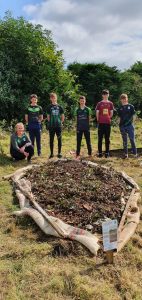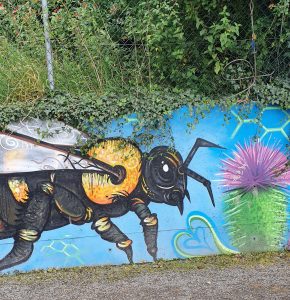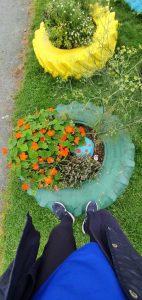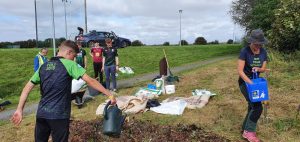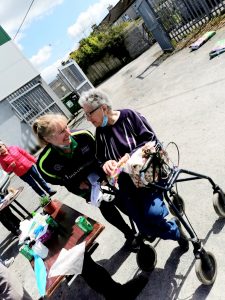By Joan Crawford, Mullingar Shamrocks Green Clubs Officer
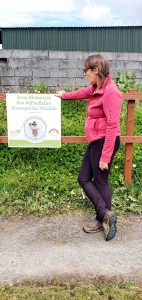 Here in the Mullingar Shamrocks GAA Club we have been ‘as busy as bees’ making positive changes for the betterment of our flora, fauna, pollinators at large and biodiversity in general.
Here in the Mullingar Shamrocks GAA Club we have been ‘as busy as bees’ making positive changes for the betterment of our flora, fauna, pollinators at large and biodiversity in general.
It all began way back in 2019 in a pre-Covid era with our entry into Tidy Towns Special Award Category for Sustainable Development. We developed seventeen vibrant, informative and colourful biodiversity signs and placed them around our Biodiversity Walking Route which is adjacent to not only Mullingar’s beautiful River Brosna but also the majestic Royal Canal. There you will see information ‘as Gaeilge’, in English, and in Latin about our native birds, fish, mammals, flora and fauna, not to mention our hugely important pollinators.
Leslie Whiteside (a local historian and eco enthusiast) educated us about our dragonflies, moths, bumblebees and butterflies. We even introduced some bug hotels and bat and bird boxes. All of these get a mention in the signs dispersed around the 860m walkway, and rightly so! We are lucky enough to have a naturally occurring solitary bee embankment, so we added to that a couple of bug hotels kindly made by a local man Peter McCahill.
Wildflower gardens
The following year, we decided to create two natural wildflower gardens and sectioned these areas off from the rest of the Club playing grounds. Happily, each of these corners are very different to each other in that one corner is a clay embankment where Spear thistle, Ragwort, Bindweed, Nettles, Docks, Dandelions, Creeping Buttercup, and Birdsfoot trefoil now grow in abundance and boy do our bees and butterflies love just hanging about there! Isolde Dingerkus, our local horticulturalist with Councillor Bill Collentine’s Mullingar Tidy Towns, has a knack of finding the hidden caterpillars here every spring and points them out to the Transition Year students, Active Retirees from Club 1428, and Mullingar HSE employees who come to participate in our Biodiversity Walking Group workshops with us each year.
Down in the far adjacent corner, our second wildflower area lends itself perfectly to lush green grasses, Meadowsweet, Creeping Buttercup, Meadow Grass, Marsh Thistle, Daisy, Dandelion and newly planted trees courtesy of Pocket Forests, Coillte, Belvedere House and Gardens and Easy Treesy, with the assistance of CBS Secondary School TY students (who also play for our club). Tree species planted here consist of native species like Hazel, Mountain Ash, Crabapple, Alder and Birch. These tree donations were all greatly appreciated.
This area is just a stones throw from our naturally occurring solitary bee embankment and little do our spectators and parents know what a hive of activity is happening behind them. As parents observe their bundles of joy playing Gaelic games, the solitary bees are simultaneously extremely busy tending to their beloved pouches which are wrapped up neatly within this clay mound. They are catered for with little packages of food for when they emerge to the rising spring temperatures and new Dandelions and flora around the hedgerows and pitches at Springfield Mullingar.
A pesticide-free club
It is for this reason that we at Mullingar Shamrocks have designated our club as a pesticide/ herbicide free club. Since we have The River Brosna flowing around half of our sports grounds and the Royal Canal is just adjacent to that, we greatly value the importance of keeping these waters free from chemicals as much as possible.
Where possible, we use lawnmowers and strimmers to maintain weeds instead. It was in this regard that we applied to LAWPRO through Croke Park’s Green Clubs Biodiversity Sub-group for a grant to buy vinegar and salt for spraying purposes to control weed growth. This organic spray is currently substituting traditional methods such as Roundup for spraying purposes. This is vitally important for the health and wellbeing of our club members, our players, our locals, our groundsmen, our environment, our local waterways and rivers, and pollinators alike. It is better all round for biodiversity and our health and wellbeing in general.
It is also good practice for our children to see these eco friendly methods being operationalised and normalised, and it is the only way to go to protect our pollinators of today, the future of our environment and for safekeeping our earth for the next generation. We are trying to return to olden ways in olden days. The beauty of being an eco-friendlier-minded club is that for once it asks us to actually do less as opposed to doing more.
The National Biodiversity Data Centre encourages us through their guidelines for the ‘Pollinator-friendly Management of Sports Clubs‘ to:
Mow less grass,
Trim fewer hedgerows,
Spray less in club grounds,
Plant more trees and pollinator-friendly flowers shrubs and herbs, and
Let nature do what it does best (leave it alone to it’s own devices).
At Mullingar Shamrocks, we employed the skills of our local tattoo artist Cowboy Davies to start a biodiversity and health & wellbeing wall mural for our club. This magnificent work in progress is the talking point of the club and spreads our key biodiversity messages very effectively with everyone who visits our club.
Local schools and crèches also get to enjoy our facilities and benefit from these initiatives through SESE, PE – Orienteering, Outdoor Pursuits, Treasure Hunts and Nature walks. Mullingar Irish Wheelchair Association, Club Active 1428 and various local community and disability groups also frequent our grounds.
We are trying to spread the messages of climate action, environmental protection, health and wellbeing, inclusion and the green agenda and sustainability for one and all to benefit from. On Saturday mornings, our Seamróigí training sessions bring with them an influx of proud parents and they must all pass by our newly erected notice boards. Thanks to Westmeath County Council and LAWPRO, these notice boards are full of environmental education and awareness-raising pictures, posters and notices. This is especially targeted at our underage section of the club and for their families alike and hopefully we are getting them to become more health and wellbeing aware and environmentally conscious.
With grants from; HSE Staff Health and Wellbeing Funding, HSE Midlands National Lottery and Westmeath County Council Local Agenda 21 funding we held numerous workshops for HSE staff, TY students from Mullingar CBS Secondary School and Active Retirees from local Club 1428, who learned about the signage from Isolde as they walked around the route. At the same time, they enjoyed physical activity, social integration and mental health benefits, and these workshops culminated in them planting pollinator-friendly window boxes consisting of: Lavandula Augustifolia Hidcote/ Blue Scent Early, Globe Thistle, Spring Celebrities Rose, Mixed Wallflower, Pincushion Flower, Foxglove, Yarrow, Sweet Rocket, Arenaria, Saxifrage, Thyme, Alyssum, Pot Marigolds and Trailing Ivy.
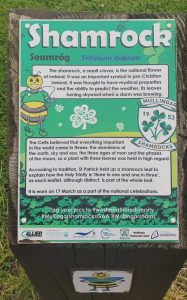 ‘Shambee’: the new club mascot!
‘Shambee’: the new club mascot!
We invited the underage team members to participate in a colouring competition where they decorated a bumblebee and had to think up a unique name for him/her which had environmental and footballing associations. All suggestions were considered and the Mullingar Shamrocks Executive voted for a winning name: “Shambee”.
Hence our little Biodiversity Walking Route mascot was born, and the winning seventeen pictures (judged by local art teacher and her children – Rachel, Katherine and Patrick Weir) were recreated into signs and erected onto our biodiversity wooden posts with each winning artists name and age included. Parents and the winning children from across all age groups attended a prize giving ceremony where they each received a pair of football socks and a pollinator-friendly plant (donated by Belvedere House and Gardens) which they could bring home to feed the bumblebees in their own gardens.
“A little bit of Shambee here
A little bit of Shambee there
It’s important to have our Shambee Pollinators
absolutely everywhere”
Our more recent project entailed the development of a Sensory Garden for the five senses and a Barefoot Sensory Walking Path. Mullingar Men’s Shed helped us create our five Sensory Boards, and we ‘d like to acknowledge Pearse McLoughlin (RIP) who contributed so much to these.
With the aid of John Bawle’s team of Mullingar Tidy Towns merry workmen, we introduced five tractor tyres, painted and filled them with pollinator-friendly plants, and decorative mushrooms and toadstools made by our local artist extraordinaire and executive member Andrina Finch.
Given the timing of this project (2021), these tyres were laid out to replicate the five Olympic Rings – after all we are a sports club! Local children visit this garden daily, where they sit with friends and play all around it. Even visiting teams for matches can’t resist a look, a touch, a listen, a smell and even a taste of its produce – the sweetcorn (for sound) is a big hit. Other plants include Oregano, Thyme and Lemon Balm for smell, Petunias and Calendula for sight, Chives for taste, and Angel wings and Lamb’s Ear for touch, which our pollinators also thrive on.
The barefoot pathway consists of bamboo canes, mulch and conifers, decorative and colourful stones, tree slices and decorative paving stones from local Kilmurray’s Hardware Store. Each end of the path has Lemon Balm and Lavender planted which gives off a lovely aroma when walked on during the summer months .
CBS TY students and our Green Clubs Initiative also planted five hundred window boxes full of pollinator-friendly plants for HSE frontline staff and Club Active 1428 Retirees Club members. These window boxes were paid for through grant aid from HSE Staff funding Initiatives and Community Enhancement funding with Westmeath County Council. Slanemore Garden Centre supplied the plants and window boxes and we partnered up with the retirement members, HSE staff and CBS students to plant and distribute them across the town of Mullingar and wider environs, benefitting many pollinators.
Working together to make a difference
In summary, no man is an island, and no club can do it all. Given funding restrictions, traditional practices, and a reluctance to change the ‘old ways’, sports clubs could be difficult places to do things differently. Thankfully, Mullingar Shamrocks have an uber-modern executive membership, an active local LAWPRO rep in Basil Mannion, trusted physical labour and expertise from Mullingar Tidy Towns (Bill Collentine, John Bawle, Isolde Dingerkus and team), and the dynamic and favourable support of Westmeath County Council grant Initiatives and staff Ruth Maxwell, Melanie McQuade, Triona Fineen, Brigid Geoghegan, Antoinette Barr Jordan, Ursula Harper, Anne Marie Nash and John Jackson.
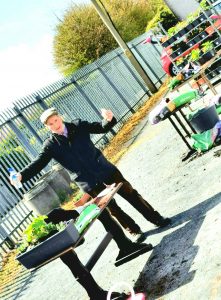 We have many other funders too numerous to mention, and the Mullingar Shamrocks Groundsmen. Without the support and assistance from these people and others, we couldn’t have achieved our goals do date: to protect, sustain and maximise the potential of our bees and many other local pollinators.
We have many other funders too numerous to mention, and the Mullingar Shamrocks Groundsmen. Without the support and assistance from these people and others, we couldn’t have achieved our goals do date: to protect, sustain and maximise the potential of our bees and many other local pollinators.
If you are with a GAA Club, why not join us on our quest with the Green Army on Croke Park’s Green Clubs?
Read more:
All-Ireland Pollinator Plan guidelines for the pollinator-friendly management of sports clubs
Joan Crawford (above left) is the Green Clubs Officer for Mullingar Shamrocks GAA Club, which is taking part in phase one of the GAA’s Green Clubs programme. She represents the Club on the GAA’s Green Clubs Water and Biodiversity sub-group.

